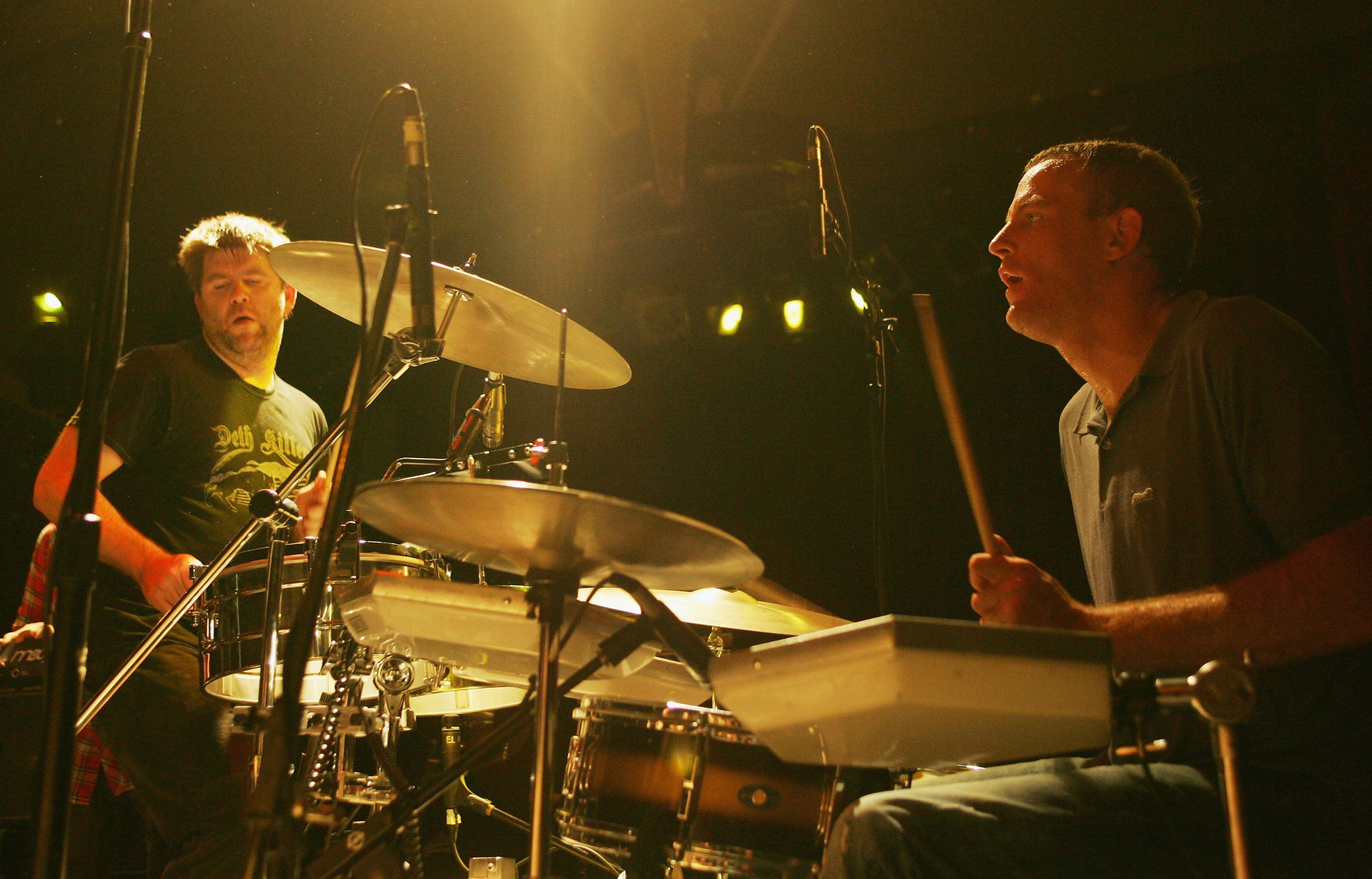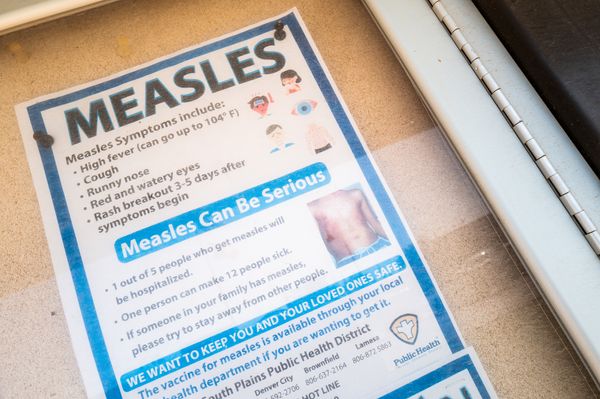
I was there. In the basement party on the Lower East Side the night James Murphy first took ecstasy. Murphy was handing round Juicy Fruit gum to the ravers and David Holmes dropped “Tomorrow Never Knows” the instant he came up.
“[My friends] were all around me chanting my name and pointing at me and I was losing my s*** to my favourite song,” Murphy told Lizzie Goodman for her 2017 book about the post-2000 New York rock scene, Meet Me in the Bathroom. “I had a revelation. This is actually me. I was fully me.” Holmes, the renowned Belfast DJ manning the decks at that bacchanalian early party thrown by Murphy’s fledgling label DFA Records (standing for Death from Above) around 2001, saw a light come on in him. “I watched his life completely change in that moment,” he said, “and it was beautiful.”
Once Murphy turned off his mind, relaxed and raved downstream, the entire NYC scene went with him. His dancefloor epiphany would not only result in a self-titled 2005 LCD Soundsystem album – released 20 years ago this week – which brought the post-punk DIY aesthetic of The Strokes and the Yeah Yeah Yeahs to electronic music, but would also act as the personification of the narrator of his debut single “Losing My Edge” playing Daft Punk to the rock kids.
LCD’s spare but explosive dance punk would build the same sort of bridges between electronica and rock over the rest of the Noughties that The Chemical Brothers and Primal Scream had for Nineties UK audiences. With the joint arrival in 2002 of “Losing My Edge” and The Rapture’s “House of Jealous Lovers” – one of the label’s first releases – the sound and energy of DFA’s wild, scuzzy parties engulfed the global underground. This writer might not literally have been there in the basement that night, but we were all there.
DFA was the brainchild of New Jersey’s Murphy – an “obsessive audio nerd”, sound engineer and avid student of the likes of The Birthday Party, Can, The Velvet Underground and “weird punk rock” – and British producer Tim Goldsworthy, previously part of James Lavelle’s revered trip-hop group Unkle. After Goldsworthy arrived in NYC in 1999, the pair partnered up as label founders (alongside manager Jonathan Galkin) and production team, initially throwing parties designed to upend and unsettle the New York norm. “[There were] punk kids, electroclash kids, drag queens, businesspeople, weirdos,” Murphy said. “Everybody had to feel like it wasn’t their place.”
The Rapture’s Mattie Safer recalls early DFA parties as ear-opening events that forced people to fundamentally rethink their sonic identities. “The things that were the most refreshing about the parties was the musical selection,” he tells The Independent. “At that time everything was very genre-specific. This is a house music party, or this is a Sixties dance party. [But] if you listened to ‘Losing My Edge’ and all of the bands that he namechecks in that song, that’s what James was playing at those parties, throwing it all together. The thing that tied it all together was this essential musical truth, as understood by James Murphy.”

The crew saw DFA as a “giant art project” fusing punk amateurism and attitude with dance music. The company’s business cards, for instance, had zero information on them, just two shaking hands and the words “f*** off, you c***”. Murphy enthusiastically landed on rising dance punks The Rapture as the band that would form the foundation of DFA operations. Their techno-influenced production on “House of Jealous Lovers” helped the band pierce the prevailing guitar rock bubble and established dance punk as a fundamental thread of the New York scene. “When we wrote that song, it was drawing influence from [independent label] Trax’s early records – house music but putting it onto a live band situation,” says Safer. “What they brought was the experience of how to take that idea and actually make it work as a club record.”
The recording also exposed Murphy’s domineering musical mentality. When The Rapture’s singer Luke Jenner took against the mix because it sounded unfinished and the delay on the guitar was wrong, Murphy told him, “We’re not fixing it, this is it.” Murphy was swiftly proven right. “House of Jealous Lovers” went from hard-to-find cult 12-inch in the New York club scene to global whirlwind. The single broke the UK Top 30 and DFA were suddenly the trendiest production team on the planet. Janet Jackson called. Britney Spears stopped by to work on a demo track. EMI offered the label a lucrative deal for first option on future DFA acts.
The thing that tied it all together was this essential musical truth, as understood by James Murphy
Rather than come with them to EMI, however, The Rapture chose to sign to Universal for $1.8m. At a point when Murphy had recently lost both parents, split with his girlfriend and, broke, was sleeping in the office, he was crushed. “That was kind of a lonely period,” he said. “But something really radical happened. It broke me free, in a way. Every day I thought ‘I’m going to die’. ‘Losing My Edge’ and the next wave of energy and combat was really driven out of that.”
Vowing revenge on The Rapture by becoming bigger than them, Murphy told EMI he had his own band, LCD Soundsystem, which didn’t yet exist. He’d been tinkering with one track called “Beat Connection” for a year – a Detroit-style psych dance piece about dancefloor repression and the emptiness of the hedonistic NYC club experience – but little else. “James was quietly working on stuff,” says Safer, “but once things between us and DFA frayed I think LCD moved up the list in terms of priority. If us getting into a big fight with DFA had one good outcome, it was maybe getting James to pay more attention to LCD Soundsystem.”
One night, Murphy locked himself alone in his West Village Plantain studio with a beatbox with a keyboard attached: a gift from Beastie Boys’ Adam Horovitz, picked up in a garage sale. Pressing play on one of the synthesiser’s preset beats (hence the sense of steam-powered electronics and Pong), he added live drums and an almost deranged art punk rant from the perspective of a bitter, aging hipster. An alternative culture Zelig, this guy “was there” at such pivotal moments in history as early Can shows, Suicide rehearsals and Jamaican sound clashes; now he was losing his edge “to better-looking people with better ideas and more talent”.
Though Murphy himself was entering the decrepitude of his early thirties, some of the friends who knew him as a wild, excitable figure on the scene wouldn’t recognise the bitter, outmoded narrator of “Losing My Edge” – a track that spatchcocked the very concept of cool and exploded rock snobbery inside eight startling minutes. But Murphy would own the character. “When I was DJing, playing Can, Liquid Liquid, ESG, I became kind of cool for a moment, which was a total anomaly,” he told the Ireallylovemusic website. “And when I heard other DJs playing similar music ... I was afraid that this newfound coolness was going to go away.”
Au contraire. “Losing My Edge” swiftly became a definitive statement on the breakneck pace of New York’s musical evolutions, the scene’s hipper-than-thou status and the city’s hunger to break out of its sonic isolation cells. “A lot of people had been in these little musical silos – ‘I’m a house guy’ or ‘I’m an indie rock guy’ – and they were just starting to question that,” says Safer. “That’s a record [where] James is questioning everything he knows about himself and about music, and the music expresses that same thing. It resonated with the time and with people’s own sense of themselves.”

Ironically, a song about dissolving kudos became the coolest and most influential sound to emerge from the US in 2002. In the UK, Hot Chip’s Joe Goddard – who would sample DFA’s drum sounds for “Boy From School” and come to work extensively with the label – found a “sonic blueprint” in the way that DFA daubed dance music with punk’s maniacal brush. “I like the rawness in the way that everything’s recorded, when you’re applying that to dance music, which no one had really done,” he tells The Independent. “Think about Steve Albini but making disco.” The humour and cynicism in “Losing My Edge” struck a chord too. “It was kind of the beginning of hipster culture, and [I loved] that New York attitude. I’d grown up thinking Lou Reed was really cool so for me it was an update of New York cool.”
Nik Colk Void, whose band Factory Floor would later sign to DFA, found the track transformative. “At the time we were still hungover from the years of Britpop and even Nirvana, so the 2000s at Trash club when they played ‘Losing My Edge’, it was kind of a revelation,” she says. “DFA felt like it was breaking that rigid structure of traditional guitar music and it opened up a whole world of looking back retrospectively at artists like Dinosaur L and Liquid Liquid. Bringing the past into the new started a new wave of creativity.”
‘Losing My Edge’ was kind of the beginning of hipster culture
Quickly spotting its debt to Killing Joke’s “Change”, however, Goldsworthy hated “Losing My Edge” and declined to join Murphy over three weeks of recording at Long View Farm in Massachusetts for the self-funded debut album. Murphy, insiders claimed, essentially taught himself programming and then shut everyone else out of the writing and recording process. Playing virtually everything himself. “The conflict for me is ‘I cannot play this music if it’s not exactly how I need it to be’,” he said.
When LCD Soundsystem finally emerged in 2005, it was 100 minutes of pure vindication. Its calling card, and LCD blueprint, was “Daft Punk Is Playing at My House”, a clattering post-disco hit made of buzzing electro riffs, spacious rhythm, minimalist punk bass and milk bottle percussion. It pictured some small-town kid saving up for years to book the superstar robots to play at the sort of house party that Murphy’s punk band had rocked back in the day. “Daft Punk would end up playing in the basement next to the washing machine, which we all did,” he imagined in the album’s press release. “I thought that would be like the best show that anyone would ever see.”
The album contained plenty more such future-junk electro tracks. “On Repeat” resembled something from a party drug edition of Tomorrow’s World, while “Yeah” attempted to trace the development of dance music through three ages: Stevie Wonder funk, Liquid Liquid Afrobeat and Daft Punk EDM. Elsewhere, though, the album acted as a melting pot of Murphy’s vast array of influences: krautrock, “Dear Prudence” psych folk, ambient and garage punk. “James had a very specific idea about that,” says Safer, “which is that on your first album you should try to do a wide breadth of things because if you just do one thing on your first album then everybody will only expect you to be able to do that one thing.”
So “Great Release” ruminated on sex and death – key album themes – in the style of a ghost-trail Beach Boys. “Tribulations” was such a devout homage to New Order that the final minute synced perfectly with the opening of “Blue Monday”. “Thrills” was essentially Jon Spencer in the 25th century and “Movement” was a crazed mash-up of Suicide, Can and The Stooges, attacking the press-touted New Rock Revolution of bands such as The Datsuns and Jet. “It’s a movement without the bother of having any meaning,” Murphy told Fused magazine in 2005. “‘Rock is back! The guitar is back!’ Whoo-hoo. But for what? It’s like saying, ‘The high-waisted pant is back!’”
James Murphy thought if you just do one thing on your first album then everybody will only expect you to be able to do that one thing
It was exactly this fusion of the experimental, the cultured and the knowingly cynical – the zeitgeist spotting its first grey hair, perhaps – which made LCD Soundsystem a landmark. It hit charts across Europe and paved the way for a decade-defining follow-up in 2007’s Sound of Silver, another record that found kudos in deep cultural knowledge and pride in the tradition of leftfield reinvention. The 1975’s Matty Healy would cite the album’s “All My Friends” as “the best song ever” and “the cool guys’ ‘Mr Brightside’”.
The partnership between Murphy and Goldsworthy would soon collapse – Murphy would sue Goldsworthy in 2013 over financial issues – and LCD would enter a four-year hiatus following 2010’s third album This is Happening. But by then Murphy had placed dance-punk at the heart of alt culture and left an impact that would long outlast those art-school Brooklynites coming up from behind. “For me it’s tied to that moment in time,” Goddard says. “It was different worlds coming together.”







